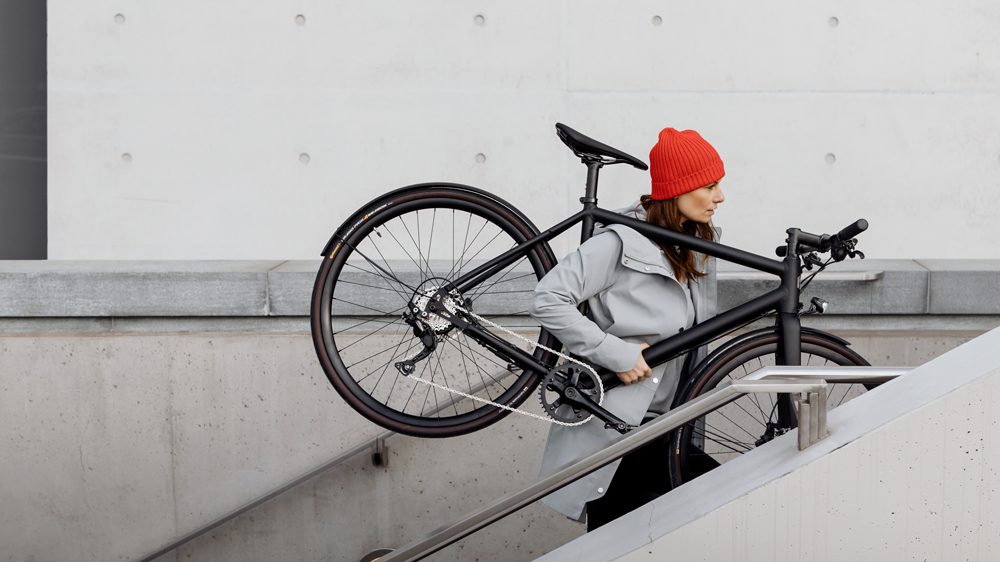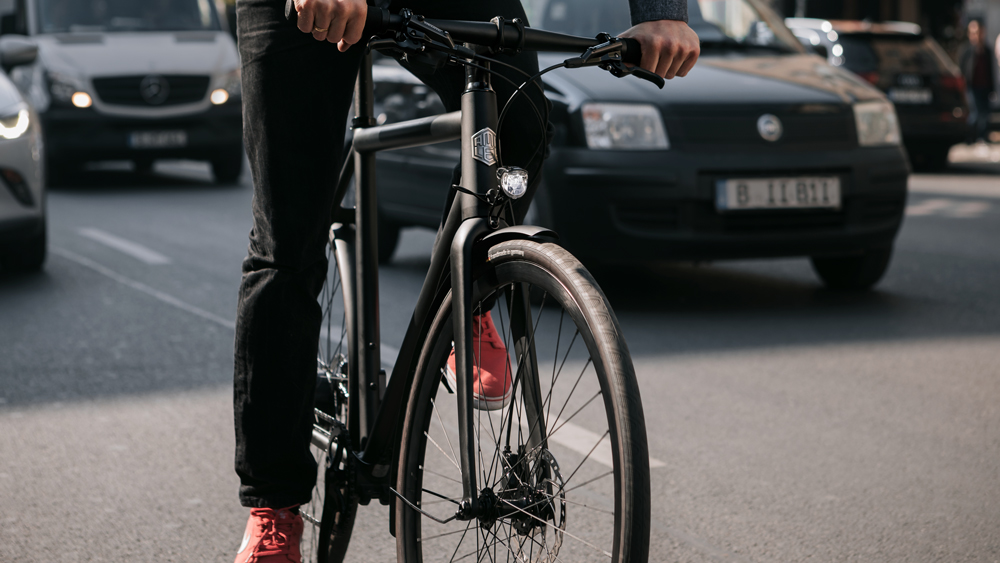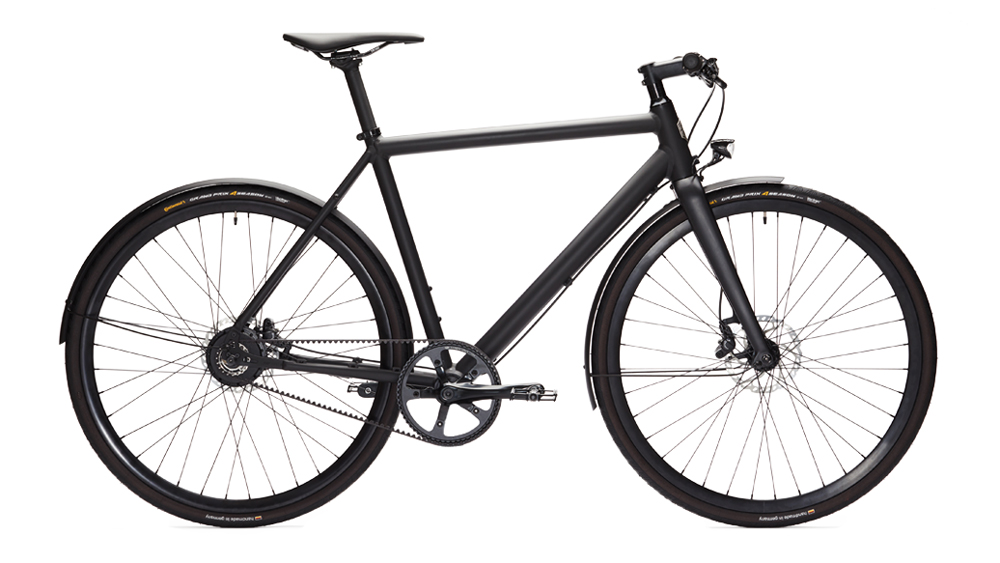You can trust Coach
Electrification has come to all of the major categories of bike now: road bikes, mountain bikes, gravel bikes, hybrids and even folding bikes. With the Cowboy e-bike and now the Ampler Curt, even the more niche flat-bar road bike has gotten the electric treatment.
Flat-bar road bikes split the difference between the more comfortable, upright riding position of a hybrid and the light and stiff frame of a road bike which is built for speed. While two isn’t really a trend, I wouldn’t be surprised if more flat bar road e-bikes were released – partly because cities are becoming more bike-friendly to cope with the people shunted off public transport in the name of social distancing, and partly because e-bikes like the Ampler Curt are very city-friendly.
The weight is one chief reason these bikes are suited to urban living. The Ampler Curt single-speed is 13.5kg (there’s a ten-speed version which weighs 14.3kg), lighter than any other e-bike I’ve tried except the Ribble ALe hybrid (13.1kg). Its flat-bar rival Cowboy is 16.1kg, while most city-suited hybrids I’ve tried are 20kg and over. That makes the Curt more manoeuvrable when riding, and much easier to carry up and down stairs – a real bonus if you live in an apartment block without a secure bike store.

Ampler has pulled off an impressive trick of hiding the battery in the downtube, like the Ribble ALe. But unlike Ribble’s effort, which uses the Ebikemotion system (which trades some power for being small and light), Ampler’s own system hasn’t noticeably sacrificed power, or at least not to the same extent as Ribble.
While hiding the battery makes the Curt look great, there is a flipside, which is that you can’t detach the battery to charge inside while your bike is locked up outside. Not a problem if you plan on keeping your bike in your home, but it could make for an added inconvenience. On the other hand, the Cowboy places its battery vertically on the seat tube and while it can be removed to be charged remotely, it’s pretty heavy and does change the centre of gravity on the bike.
Like the Cowboy, the Curt single-speed also uses a rubber belt instead of a chain, so there’s no chance of getting grease on your clothes – plus mudguards come as standard. And since there’s little need to work up a sweat on an e-bike unless you have to go faster than 25km/h (when the motor cuts out in accordance with UK law), you’re very unlikely to have to change clothes at your destination – making the Curt a very convenient way to get around.
See related
- Save £££s On An E-Bike Using The Cycle To Work Scheme
- The Best Electric Bikes For Commuting
- Electric Bike Buyers’ Guide
The downside of a rubber belt is that it won’t be as efficient as a well-maintained chain, but then I’m not great at maintaining my bikes and anyway there’s a motor to pick up the slack. Cycling without the motor isn’t even that bad – in fact on my first ride it took a while for me to clock that one of the modes is “no assistance” (why?!). Otherwise there are normal and boost moods, with the latter providing 50% more assistance. I spent practically all my riding time in boost mode, which felt like you were getting turbo-charged assistance. The normal mode did help a little, but I’d rather let the motor do as much of the work as possible.
This did mean I found the battery didn’t get close to the quoted 70km range. On an 8km round trip using the boost mode with the integrated lights (another notable convenience) I found the battery level dropped by around a quarter. It doesn’t strike me as a problem though – this isn’t a touring bike. One 18km-long cruise to the river and back to escape lockdown for a bit pushed the limits of comfort, with the hard seat and stiff frame (despite the carbon fork which reduces the vibrations travel through the bike) better suited to shorter journeys.
The Curt has one button placed next to the charging socket by the bottom bracket, which can be used to turn the bike on and cycle between modes. I’m surprised it’s located there because it’s not very convenient – the Ribble ALe and Cowboy both place their single button on the crossbar so you can switch mode mid-ride. Like the Cowboy, the Curt connects to an app over Bluetooth, allowing you to turn the lights on, switch between modes and adjust the amount of assistance provided in normal and boost modes.

There’s also the ability to plan routes and navigate, although only if you can mount your phone on the bike because it’s visual only, rather than including audio cues. The routing software looked promising, however, choosing quieter back roads rather than the A-roads Google Maps preferred when I did a side-by-side test.
It’s a well-designed, modern app and I only had one connection problem, which was solved with the standard rigamarole of making my phone forget the Bluetooth connection and starting over again. It’s certainly an order of magnitude better than some I’ve tried (cough GoCycle cough), but doesn’t reach the heights of Cowboy’s, which includes support live chat and an integrated tracking SIM in the bike so you can find it if it’s nicked (although you can insure the Curt against theft and damage for the reasonable annual cost of €120 through Ampler).
A few other things are worthy of mention: Curt uses hydraulic brakes, which are more powerful than rim brakes and perform better in the wet. The tyres are reasonably wide and puncture-protected, and in a surprisingly practical move for a sleek single-speed, attachments (sold separately, €25) to the rear axle make it suitable to use with a Thule trailer.
The bike set-up experience is worthy of praise. All other bikes I’ve had shipped to me involve you leaning in and lifting out. That would not have been so much of a problem with a bike as light as the Curt, but it can be a bit awkward. However, with the Curt the box lifts off a base which keeps the Curt upright so you can finish the set-up – turning the handlebars around and attaching the pedals.
A post shared by Ampler Bikes (@amplerbikes)
A photo posted by on
It’s all very easy with clear instructions – and bear in mind this comes from someone who once put the handlebars on a review bike the wrong way round.
Perhaps the biggest thing the Curt has in its favour, at the moment at least, is that it arrives in between seven and 14 days. The UK is virtually sold out of bikes, e-bikes or otherwise, with Cowboy on an eight-week delivery schedule and Ribble offering to dispatch the ALe on 15th September.
The Curt does cost more, something like £2,600 depending on the exchange rate (the cost can be split over three months with Klarna, interest-free), in contrast to the Ribble ALe and Cowboy which are both around £2,000. The Curt has advantages over the Ribble in that it’s more powerful, although perhaps less practical (Ampler’s slightly cheaper Stout/Stellar commuter bikes are better rivals to the ALe).
In a straight head-to-head, taking price into account, the Cowboy edges it. Even though the ride isn’t as pleasant, the addition of a SIM and the convenience of a removable battery are major advantages which you pay less for. You’ll have to wait for the Cowboy, though, and if you’re a bit stuck getting around a major city without a car (or are fed up sitting in traffic in one), Ampler will get you in the saddle in next to no time – and you won’t be disappointed with the experience.
Buy from Ampler | Single speed €2,890 (around £2,600)

Jonathan Shannon was the editor of the Coach website from 2016 to 2024, developing a wide-ranging experience of health and fitness. Jonathan took up running while editing Coach and used the training plans on the site to run a sub-40min 10K, 1hr 28min half marathon and 3hr 6min marathon. He’s an advocate of cycling to work and is Coach’s e-bike reviewer, and not just because he lives up a bit of a hill. He also reviews fitness trackers and other workout gear.

